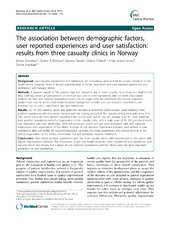| dc.contributor.author | Danielsen, Kirsten | en_US |
| dc.contributor.author | Bjertnæs, Øyvind Andresen | en_US |
| dc.contributor.author | Garratt, Andrew | en_US |
| dc.contributor.author | Førland, Oddvar | en_US |
| dc.contributor.author | Iversen, Hilde Hestad | en_US |
| dc.contributor.author | Hunskår, Steinar | en_US |
| dc.date.accessioned | 2011-04-11T09:15:48Z | |
| dc.date.available | 2011-04-11T09:15:48Z | |
| dc.date.issued | 2010-10-06 | eng |
| dc.Published | BMC Family Practice 11:73 | en_US |
| dc.identifier.issn | 1471-2296 | |
| dc.identifier.uri | https://hdl.handle.net/1956/4647 | |
| dc.description.abstract | Background User reported experiences and satisfaction are increasingly used as basis for quality indicators in the health sector. However, there is limited understanding of factors associated with user reported experiences and satisfaction with casualty clinics. Methods A random sample of 542 patients that had contacted any of three casualty clinics from mid April to mid May 2008 was mailed a questionnaire. A reminder was sent to non-respondents after six weeks. Descriptive statistics for four user reported experiences scales and 20 single items are presented. Multivariate regression analysis was used to assess associations between background variables and user reported experiences, and between user reported experiences and user satisfaction. Results 225 (41.5%) patients, carers and guardians returned a completed questionnaire. Users reported most positive experiences with the doctor services and the nursing services at the casualty clinics; on a scale from 0 to 100, where 100 is the best possible experience the doctor scale was 82 and the nursing scale 81. Users reported least positive experiences with the organization of the casualty clinic, with a scale score of 65. Self perceived health was associated with user satisfaction, while self perceived health and age were associated with user reported experiences with organization of the clinics. A range of user reported experience domains were related to user satisfaction, after controlling for socio-demographic variables, including experiences with doctor services at the clinics, organization of the clinics, information and self perceived incorrect treatment. Conclusions Users report positive experiences with the three casualty clinics, with organization as the aspect with largest improvement potential. The importance of age and health status for users' experiences and satisfaction with casualty clinics was shown, but a range of user reported experiences with the clinics were the most important predictors for user satisfaction. | en_US |
| dc.language.iso | eng | eng |
| dc.publisher | BioMed Central | eng |
| dc.rights | Attribution CC BY | eng |
| dc.rights.uri | http://creativecommons.org/licenses/by/2.0 | eng |
| dc.title | The association between demographic factors, user reported experiences and user satisfaction: results from three casualty clinics in Norway | en_US |
| dc.type | Peer reviewed | |
| dc.type | Journal article | |
| dc.description.version | publishedVersion | en_US |
| dc.rights.holder | Copyright 2010 Danielsen et al; licensee BioMed Central Ltd. | |
| dc.rights.holder | Danielsen et al. | |
| dc.identifier.doi | https://doi.org/10.1186/1471-2296-11-73 | |
| dc.identifier.cristin | 525062 | |

